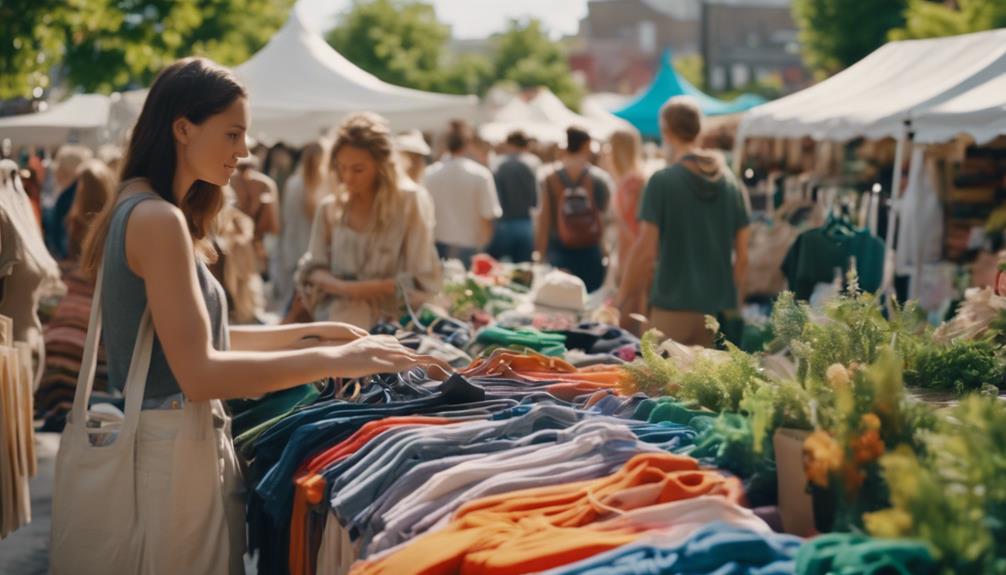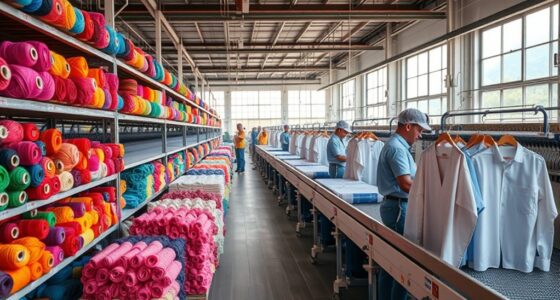Sustainable fashion is about making thoughtful decisions that reduce environmental impact. You can begin by shopping at thrift stores, participating in clothing swaps, or renting outfits for special occasions. Choosing quality over quantity ensures that your clothes will last longer. Look for brands that prioritize ethical production and transparency in their supply chains. Additionally, incorporating a circular approach by recycling and upcycling can significantly decrease waste. By changing your habits, you can help create a healthier planet while maintaining a stylish appearance. Stay tuned for more ways to easily embrace sustainable fashion!
Key Takeaways
- Participate in clothing swaps to exchange items and reduce overall consumption, promoting a sharing culture.
- Support thrift and consignment stores to extend the life cycle of clothing and minimize waste.
- Utilize rental services to enjoy various styles without committing to ownership and contributing to fast fashion waste.
- Prioritize purchasing high-quality garments that last longer, reducing the frequency of replacements and environmental impact.
Understanding Sustainable Fashion
Sustainable fashion focuses on creating clothing that respects both the environment and the people involved in its production. By prioritizing eco-friendly materials and ethical production practices, you can help reduce the fashion industry's significant impact on global greenhouse gas emissions, which accounts for 8-10% of the total.
Embracing sustainable fashion means you support a shift towards a circular economy, where recycling, upcycling, and designing for longevity are essential. This approach minimizes waste and encourages the thoughtful use of resources.
Ethical fashion complements sustainable practices by ensuring fair labor practices and transparency throughout the supply chain. When you choose brands that prioritize ethical fashion, you're not just investing in quality clothing; you're also advocating for the rights of workers and promoting responsible sourcing.
Consumer awareness plays a crucial role in this movement. Research shows that 66% of consumers are willing to pay more for ethically produced products, signaling a growing demand for change in the industry.
Key Practices for Sustainability

To promote sustainability in fashion, you should prioritize quality over quantity, ensuring each piece you invest in lasts longer and has a smaller environmental footprint. This approach aligns with the sustainable fashion movement and encourages responsible fashion choices that benefit both you and the planet.
Consider these key practices for sustainability:
- Engage in clothing swaps: Participate in community events where you can trade clothes with others. This fosters a culture of sharing and minimizes individual consumption.
- Utilize thrift and consignment stores: Shopping second-hand not only supports sustainable practices but also helps reduce the demand for new production, leading to lower greenhouse gas emissions.
Challenges in Sustainable Fashion

Steering through the challenges in sustainable fashion can feel overwhelming, especially with the industry's significant impact on the environment and the complexities of consumer behavior. The fashion industry contributes 8-10% of global greenhouse gas emissions, emphasizing the urgent need for sustainable practices.
However, many consumers resist paying more for sustainable products, creating a barrier for sustainable brands trying to compete with fast fashion retailers, which thrive on low costs and convenience. Greenwashing complicates matters further. Major brands often use vague sustainability claims, leading to confusion and distrust among consumers.
This skepticism makes it harder for genuine sustainable brands to gain traction in a market flooded with misleading information. Additionally, the limited availability of sustainable materials and the higher production costs associated with eco-friendly practices pose significant challenges for ethical fashion brands.
In a culture dominated by fast fashion, the focus on immediate gratification often overshadows the significance of long-term sustainability. As you navigate your fashion choices, it's vital to recognize these challenges and consider how they impact the broader push for a more sustainable industry.
Impact of Consumer Choices

Your choices as a consumer play an essential role in shaping the fashion industry's impact on the environment, influencing everything from production practices to waste generation. When you decide what to buy, you're not just choosing a product; you're affecting the overall sustainability of the fashion industry.
Consider these points about your purchasing habits:
- Mindful Purchasing: About 60% of clothing items are discarded within a year. Think about longevity when buying.
- Support Sustainable Brands: 66% of consumers are willing to pay more for ethically produced products. Your support can drive demand for sustainable brands.
Future Trends in Fashion Sustainability

Increasingly, the fashion industry is embracing sustainability, paving the way for innovative trends that prioritize eco-friendly practices and consumer awareness.
One notable trend is the rise of second-hand and rental markets, which offer sustainable products and promote circular economy principles. This shift not only provides alternatives to fast fashion but also encourages you to rethink your purchasing habits.
Innovations in textile technology are another area to watch. With lab-grown materials and advanced recycling methods on the horizon, fabric production will become more ethical and sustainable, reducing waste considerably.
Additionally, as brands collaborate more with environmental organizations, you can expect greater transparency in sourcing and production practices, making it easier to choose brands that align with your values.
Legislative changes are also in the works, potentially enforcing stricter sustainability standards and holding companies accountable for their environmental impacts.
As these changes unfold, online platforms dedicated to ethical fashion education will empower you to make informed choices. By demanding more sustainable options, you not only support ethical practices but also contribute to a healthier planet for everyone.
Frequently Asked Questions
How Can Sustainable Fashion Be Achieved?
You can achieve sustainable fashion by choosing durable materials, reducing waste through recycling and upcycling, supporting ethical brands, and making mindful purchasing decisions. Each choice you make contributes to a healthier planet and a better industry. By choosing sustainable fashion, you are not only reducing your environmental impact, but also supporting fair labor practices and the well-being of garment workers. This is why ethical fashion is vital. By supporting ethical brands, you are ensuring that workers are paid fair wages and are working in safe conditions. Additionally, sustainable fashion helps reduce the demand for fast fashion, which often exploits both workers and the environment.
What Are the 4 R's of Sustainable Fashion?
The 4 R's of sustainable fashion are Reduce, Reuse, Recycle, and Repair. You can minimize waste by choosing quality over quantity, swapping clothes, repurposing materials, and fixing damaged items instead of throwing them away.
What Are the 7 Rs of Sustainable Fashion?
Imagine a garden thriving with vibrant, reused blooms. The 7 Rs of sustainable fashion—Refuse, Reduce, Reuse, Repair, Recycle, Resell, Rotate—help you cultivate a mindful wardrobe, nurturing the planet with every thoughtful choice you make. Incorporating the 7 Rs into your fashion choices not only reduces waste and minimizes environmental impact, but it also supports ethical and fair labor practices in the fashion industry. By embracing sustainable fashion, you are contributing to the preservation of traditional crafts and cultural heritage around the world. For example, traditional architecture in Laos is often constructed using locally sourced materials and techniques passed down through generations, and by supporting sustainable fashion, you can help ensure that these traditional practices continue to thrive.
What Are the 5 Rs of Sustainable Fashion?
The 5 Rs of sustainable fashion—Refuse, Reduce, Reuse, Recycle, and Rot—encourage you to minimize waste. By adopting these practices, you can greatly lower your environmental impact and support a more sustainable fashion industry.
Conclusion
As you commence your journey through sustainable fashion, remember that every small choice you make is like planting a seed in a lush garden of possibilities.
Embrace the art of mindful consumption, for your wardrobe can bloom with vibrant, eco-friendly treasures.
While challenges may cast shadows, your conscious decisions shine like sunlight, nurturing a brighter future.
Let your style be a gentle whisper of change, weaving a tapestry of hope and responsibility in the fabric of our world.









